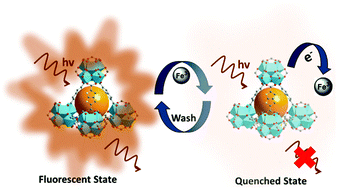The effect of functional groups in the aqueous-phase selective sensing of Fe(iii) ions by thienothiophene-based zirconium metal–organic frameworks and the design of molecular logic gates†
Abstract
The synthesis of four isoreticular, water-stable Zr(IV) metal–organic frameworks (MOFs) was conducted under solvothermal conditions by using thienothiophene-based ligands. The MOFs were fully characterized by XRPD analyses, FT-IR spectroscopy and TG analyses. The ligands were systematically modified with methyl and phenyl groups for tuning the fluorescence and hydrophobic behaviour of the MOFs. The photophysical properties of free ligands and the corresponding MOFs were investigated by steady-state as well as time-resolved fluorescence experiments. The MOFs containing π-electron rich, conjugated thieno[3,2-b]thiophene units were employed for the sensing of metal ions. All the MOFs displayed high selectivity and sensitivity towards the sensing of biologically important Fe3+ ions in pure aqueous medium through the fluorescence quenching mechanism. Detailed experimental investigations suggest that the transfer of electrons from the electron-rich frameworks to the half-filled 3d orbitals of Fe3+ ions results in fluorescence quenching. Surprisingly, the electron acceptor methyl viologen (MV2+) ions exhibited a reverse trend in the quenching efficiency compared to the Fe3+ ions. Both the steric and electronic effects of the attached functional groups can be proposed to play determining roles in the fluorescence quenching mechanism. All the MOFs showed high photostability and reusability, which are beneficial for the long-term real-world detection of Fe3+ ions. Interestingly, the MOFs can be utilized to construct molecular logic gates for the efficient discrimination between Fe3+ and Fe2+ ions.

- This article is part of the themed collection: Spotlight Collection: MOF Sensors


 Please wait while we load your content...
Please wait while we load your content...